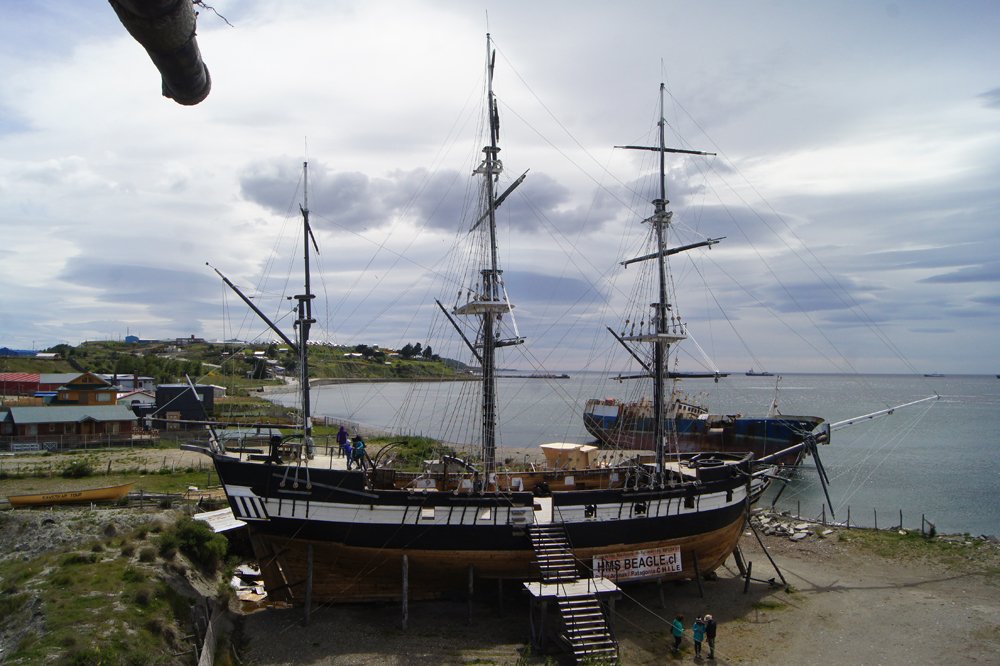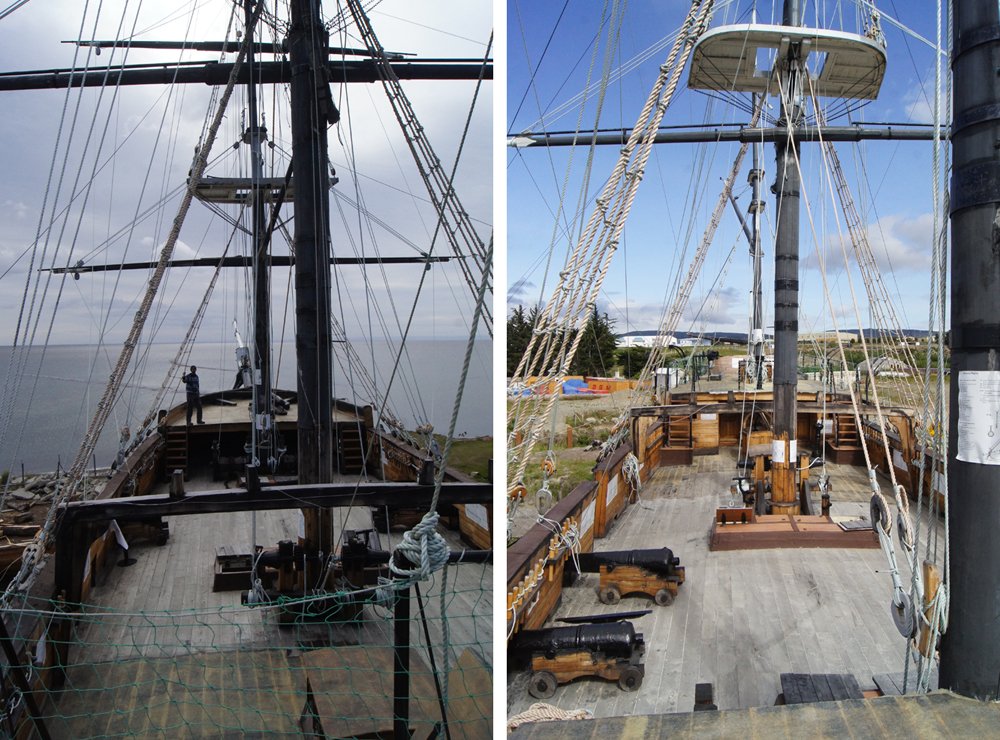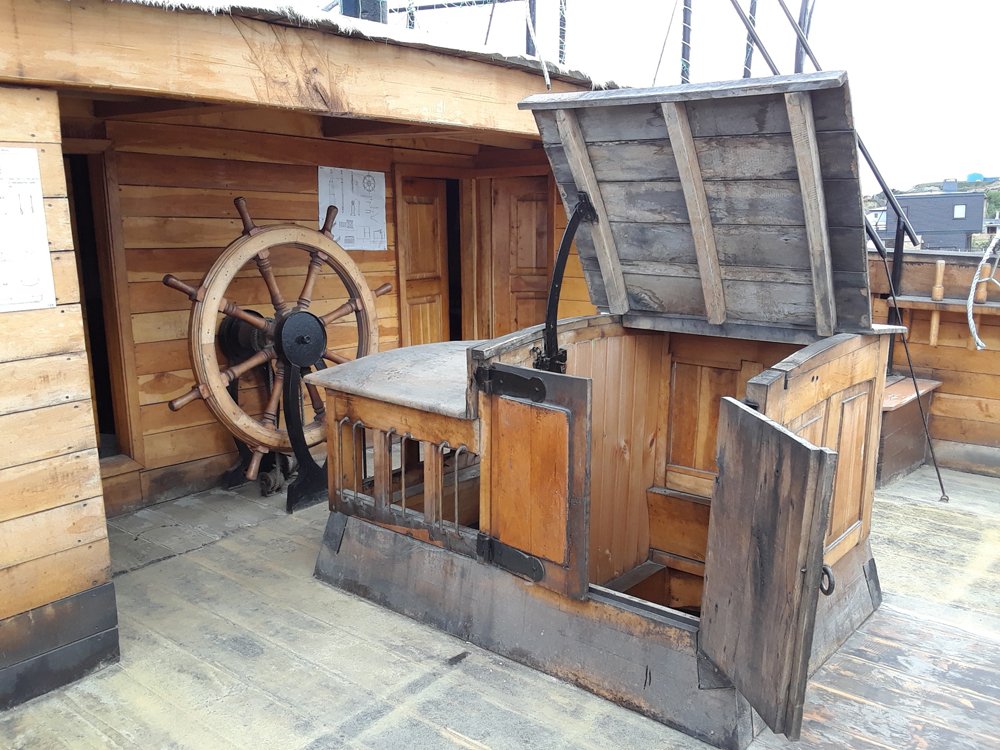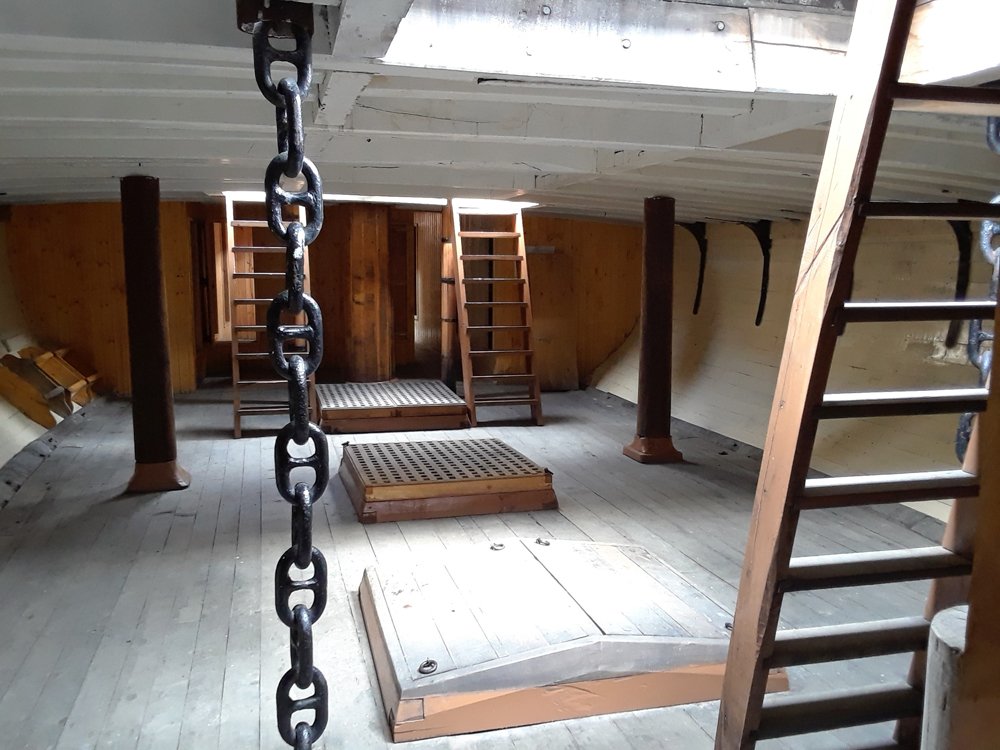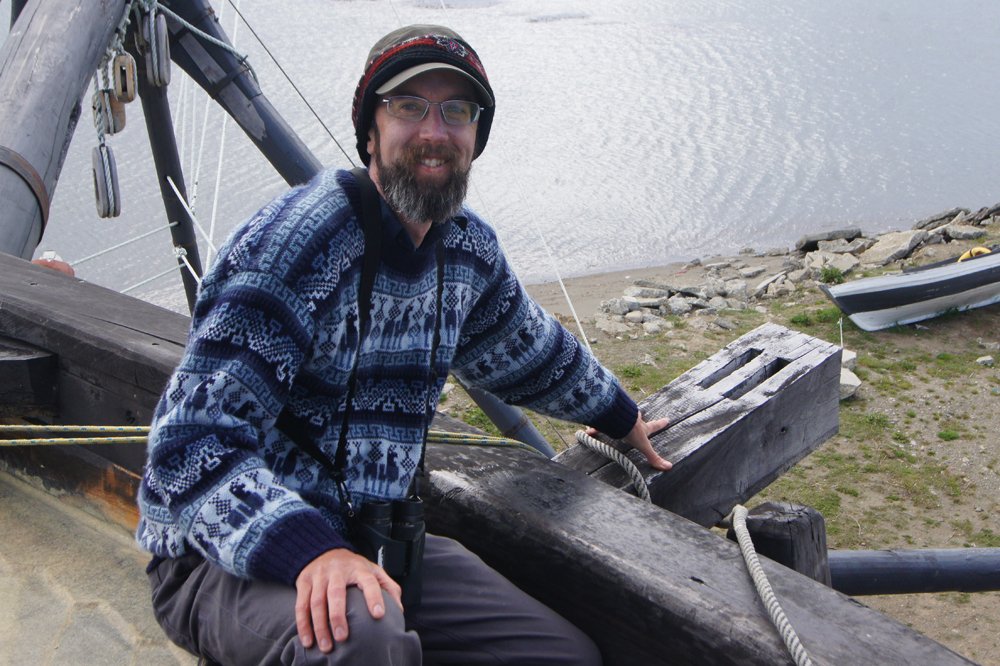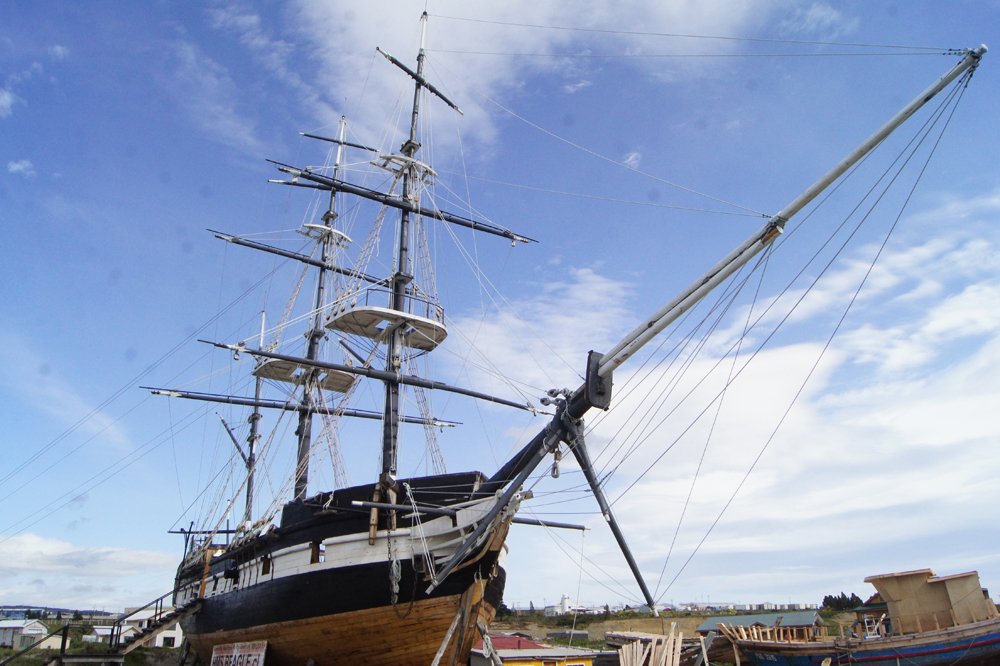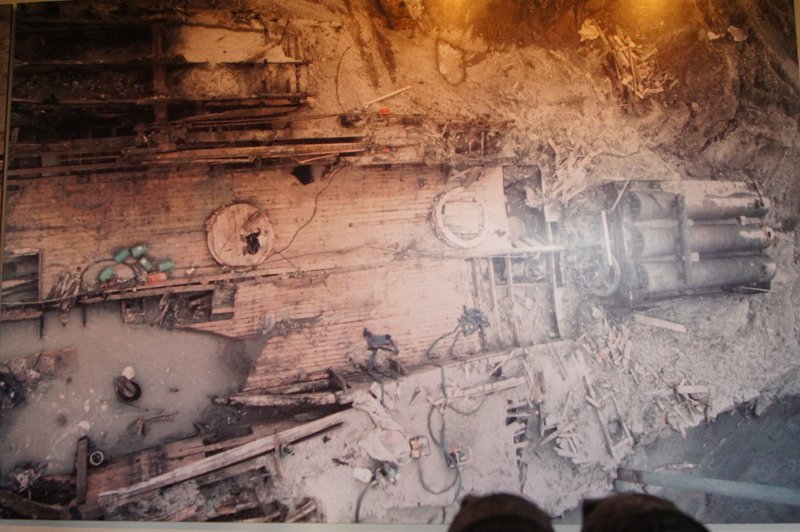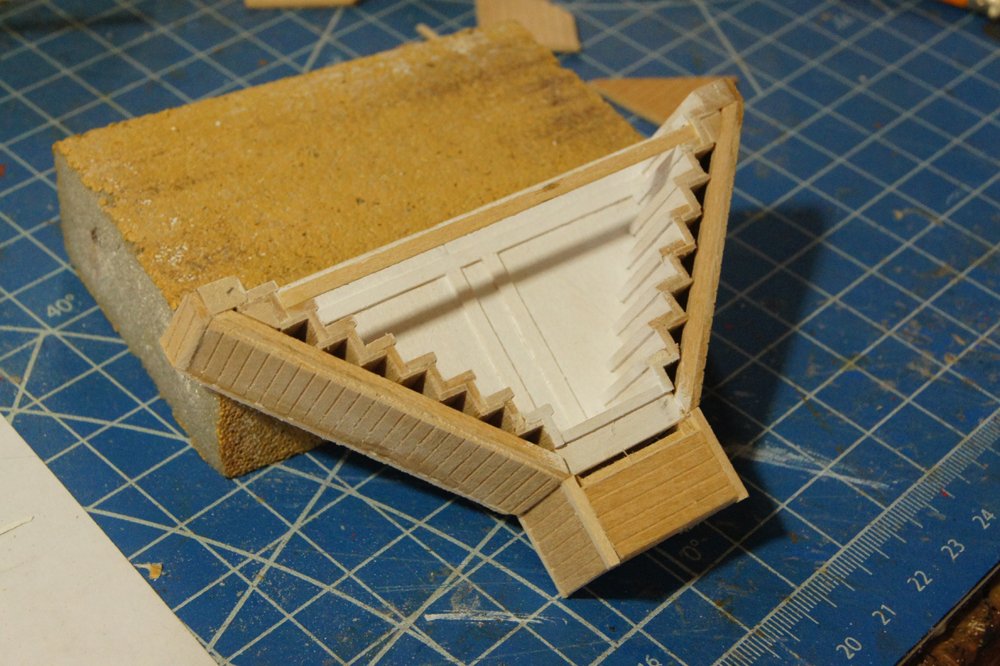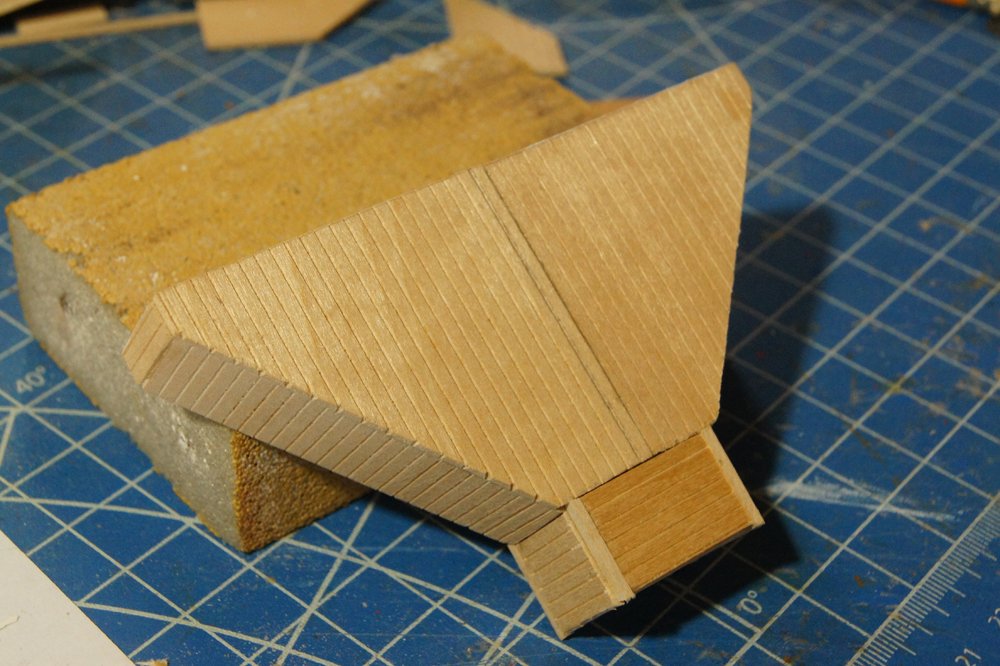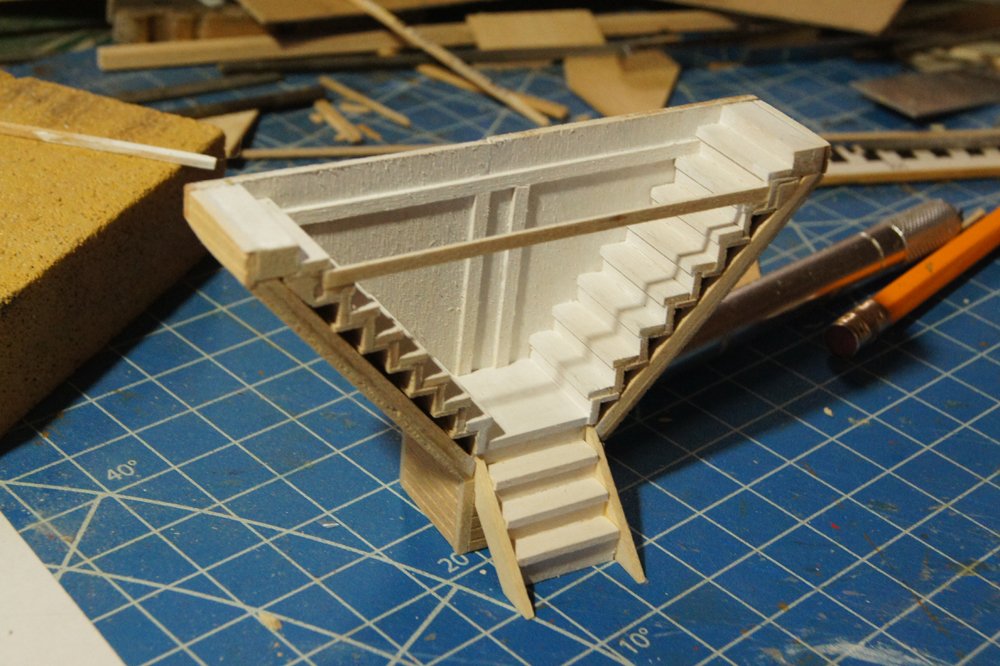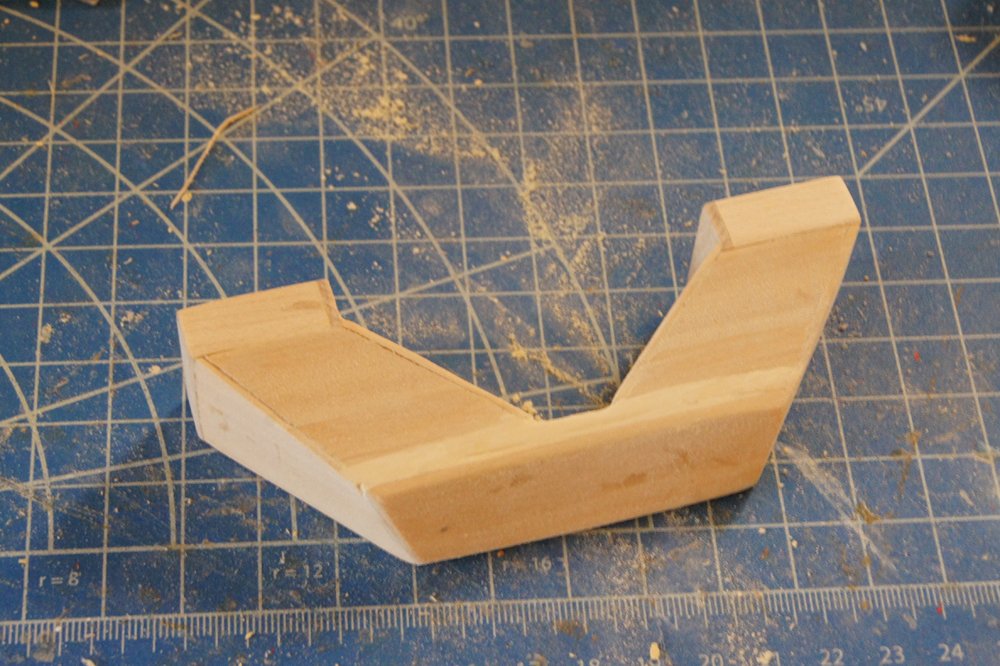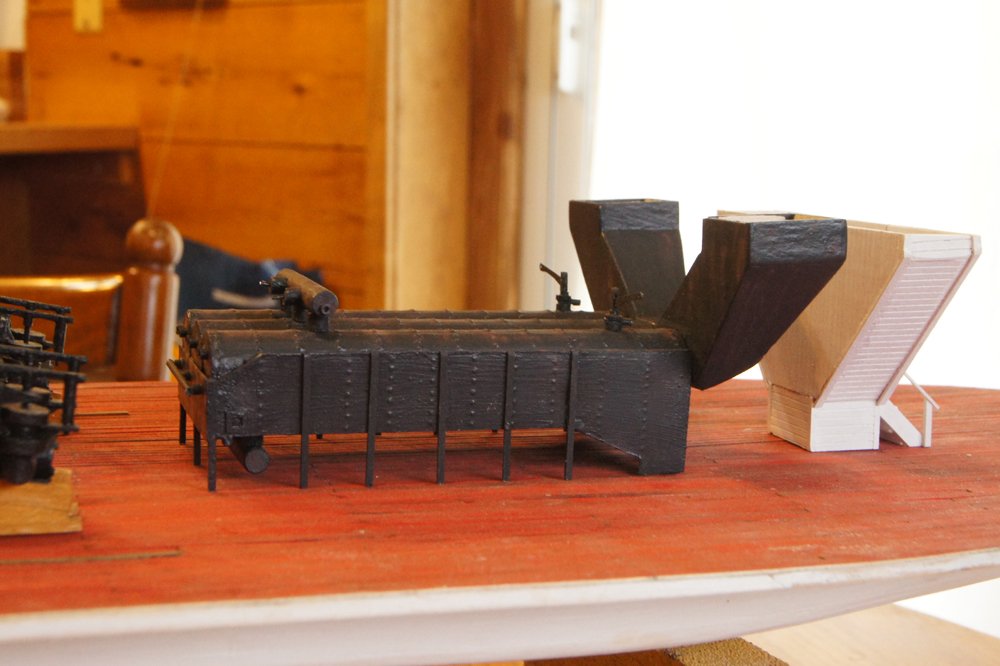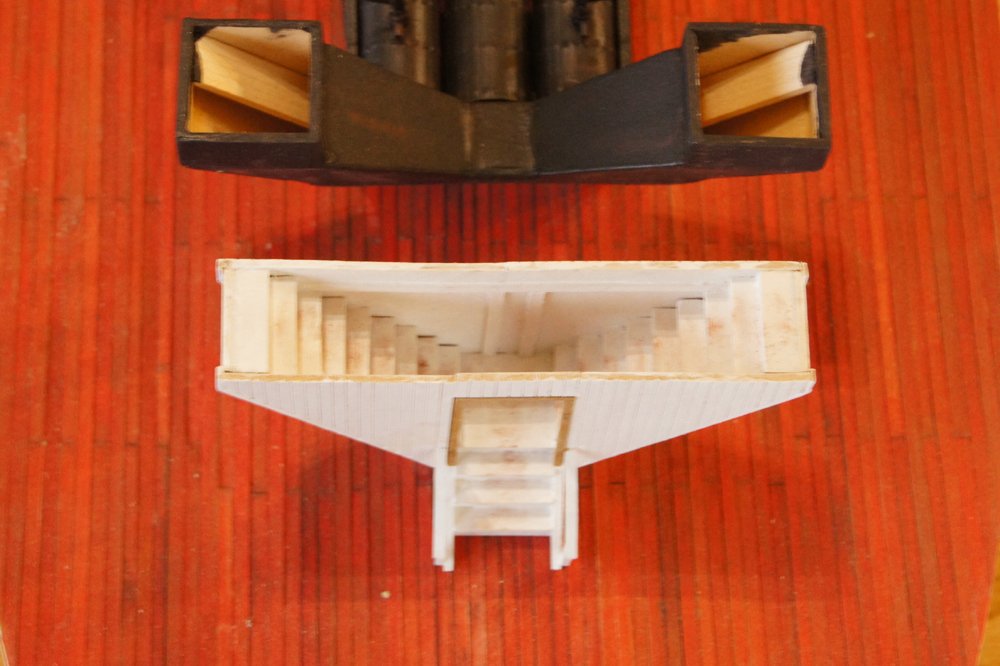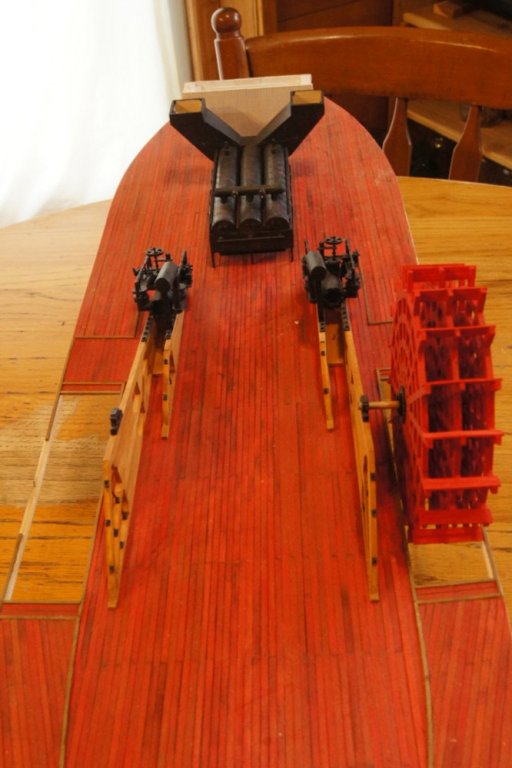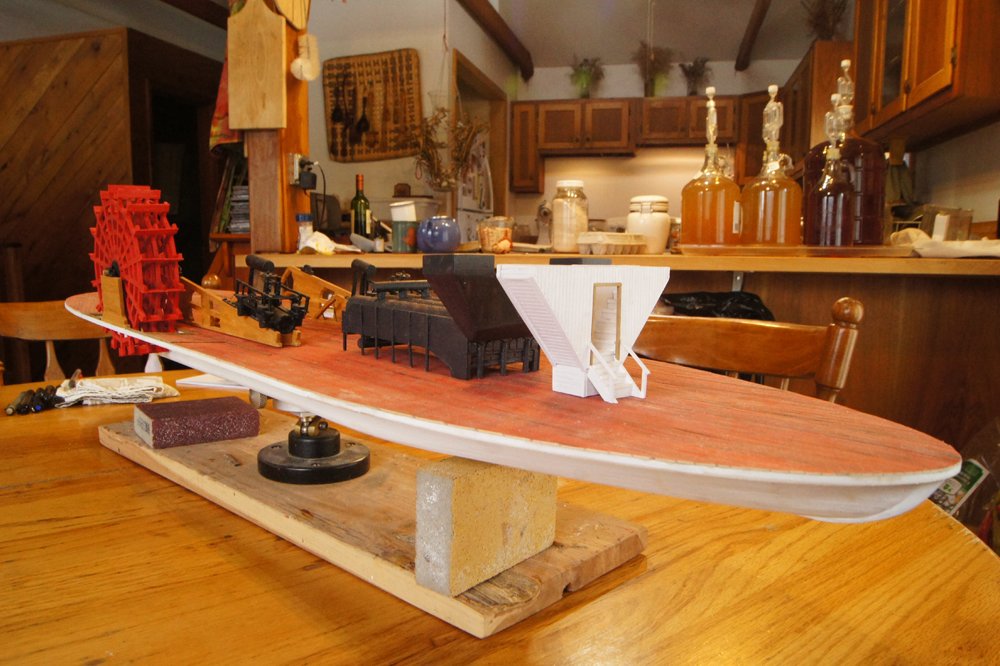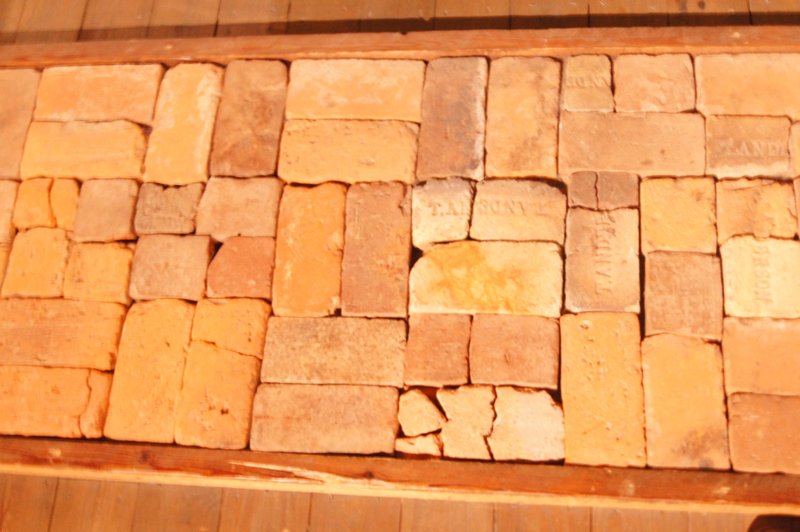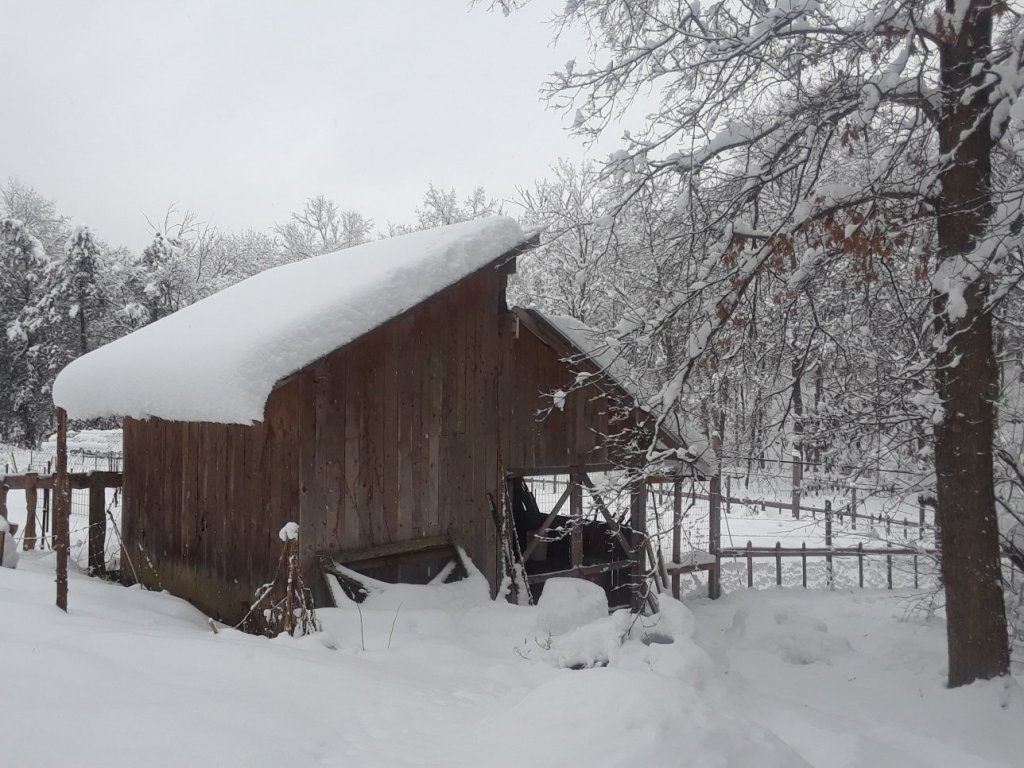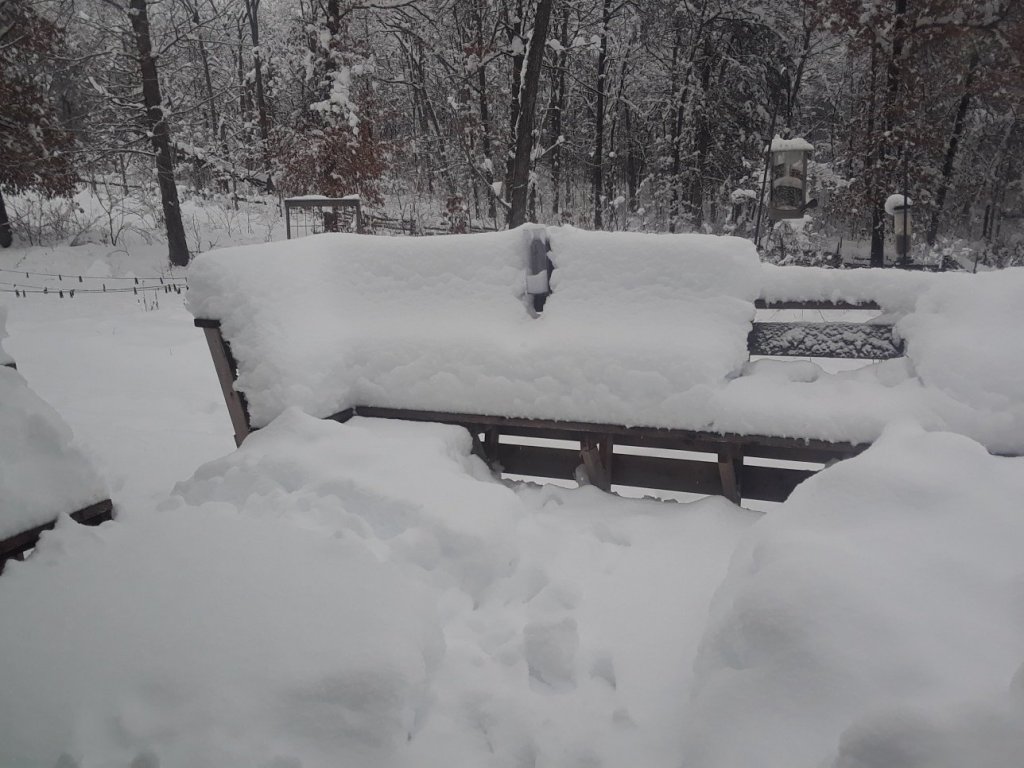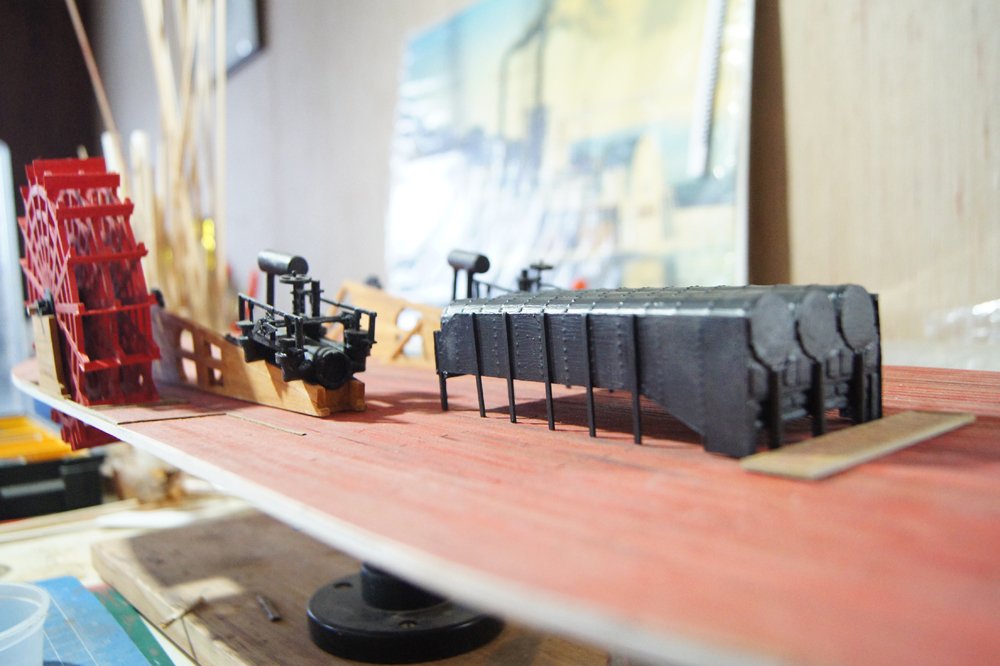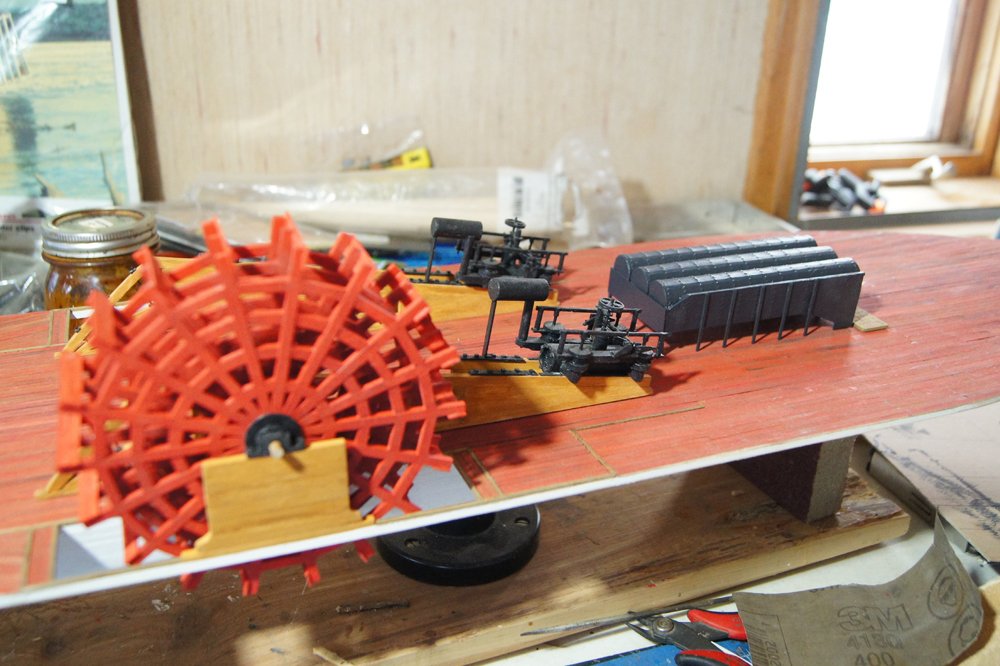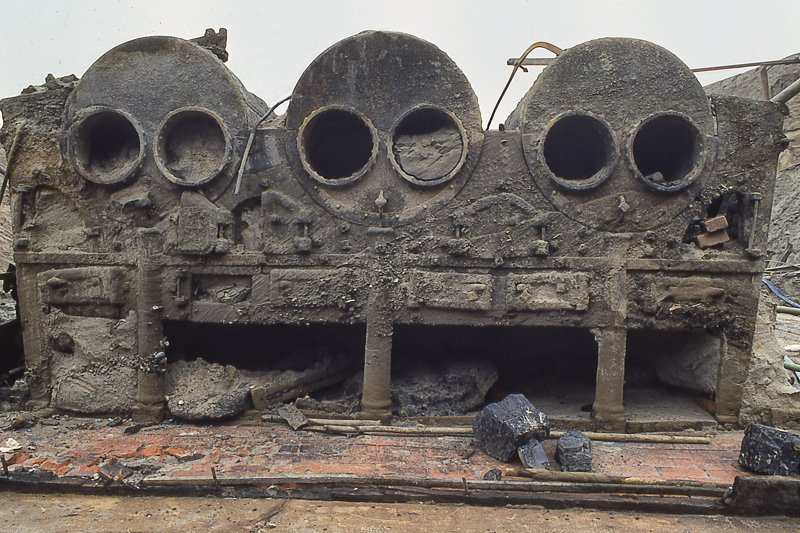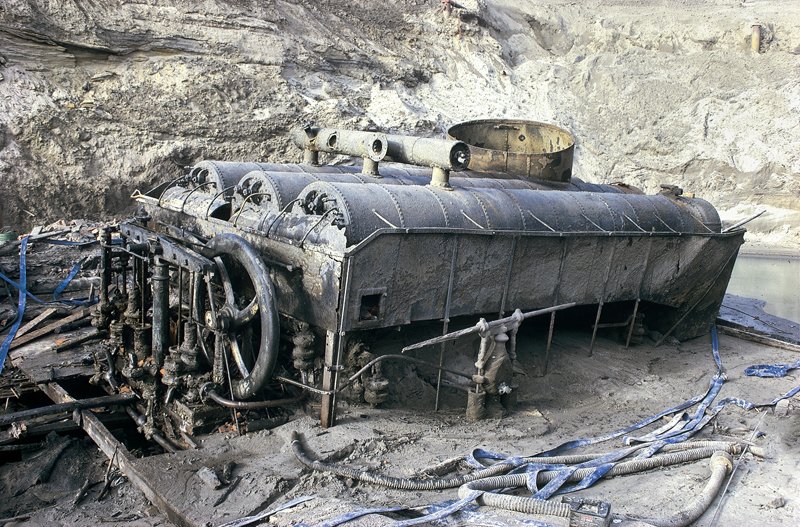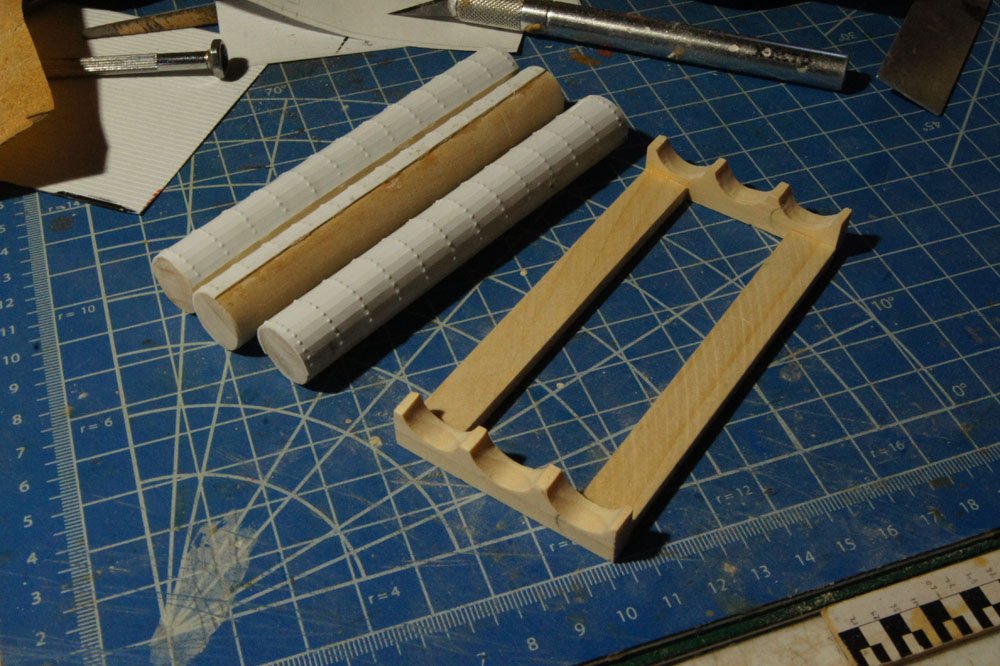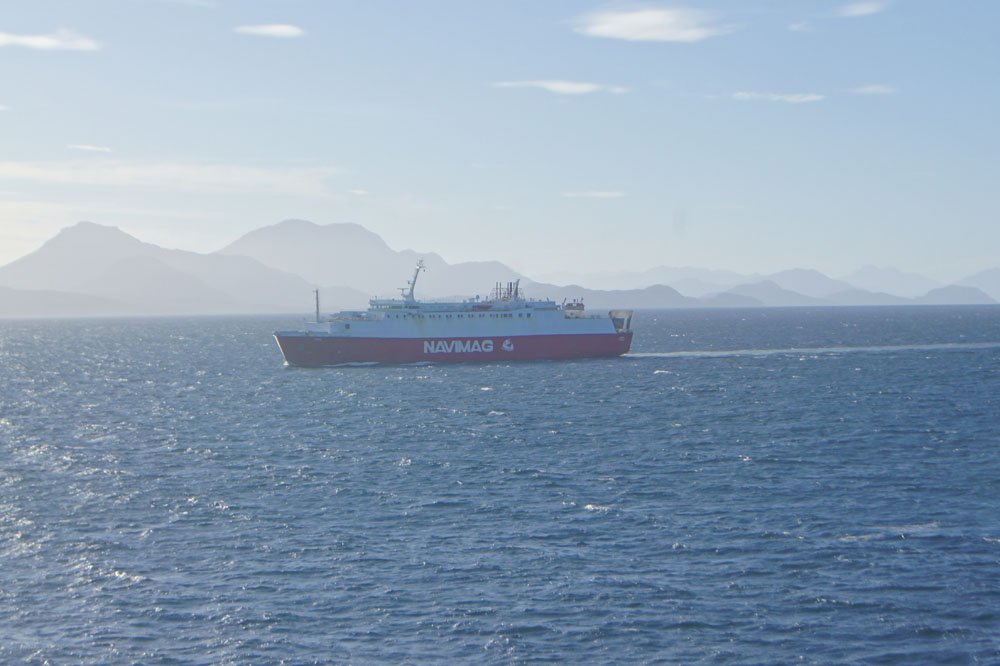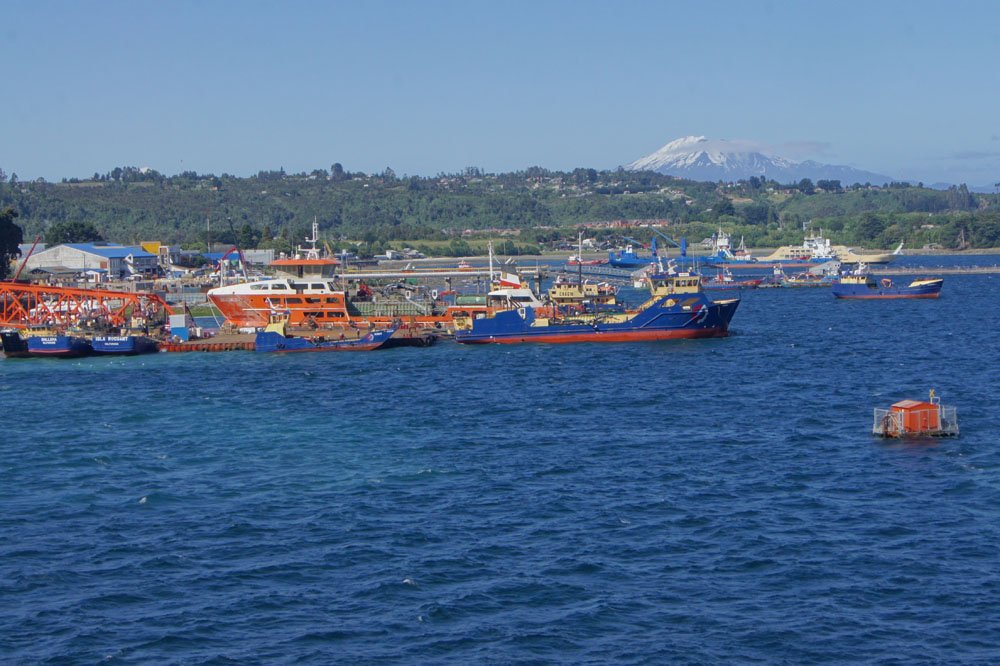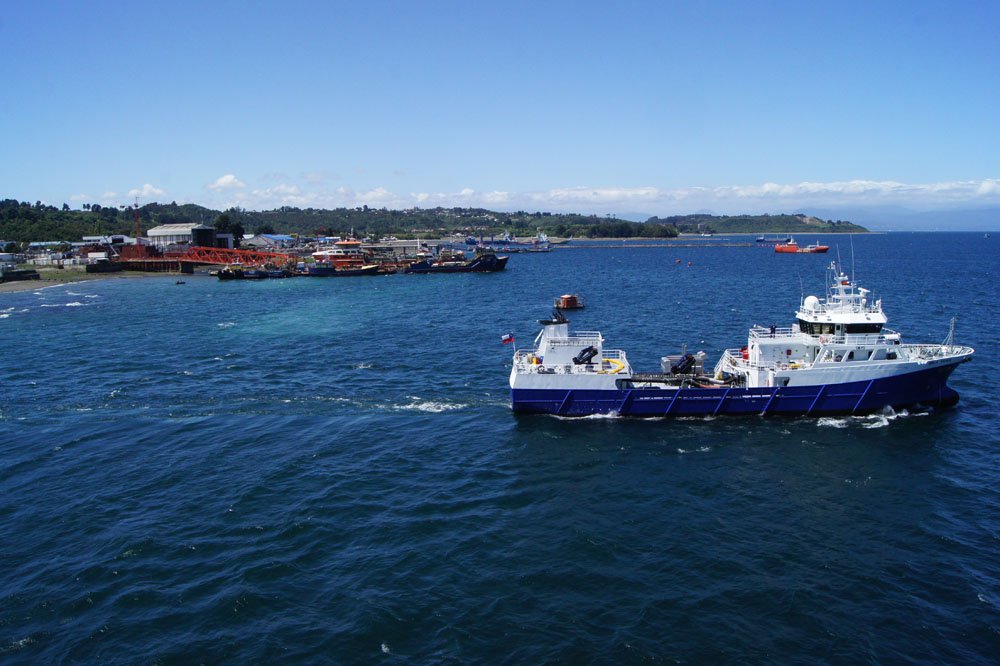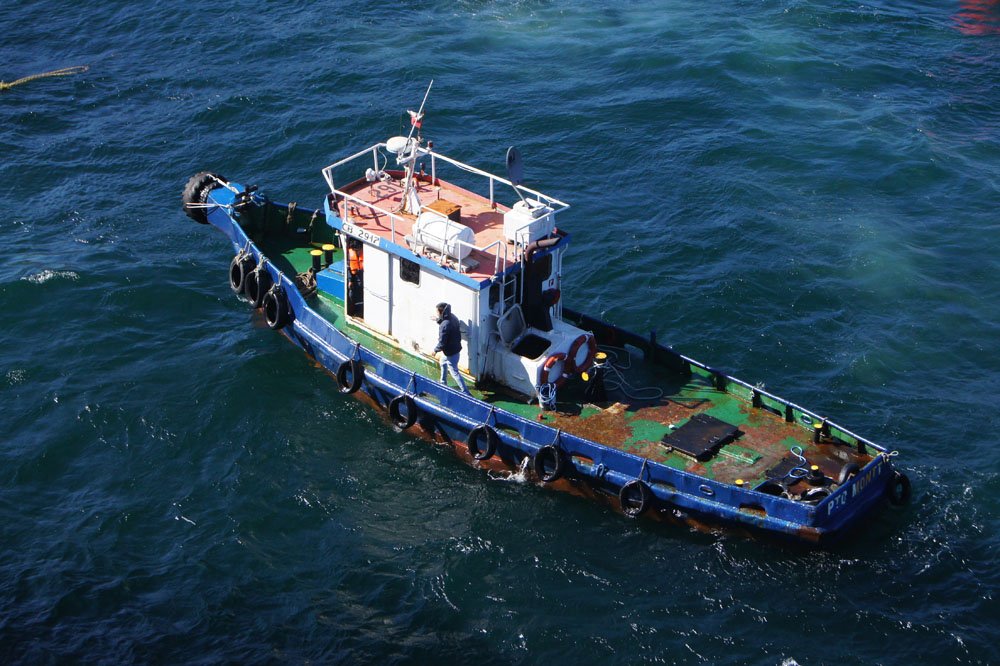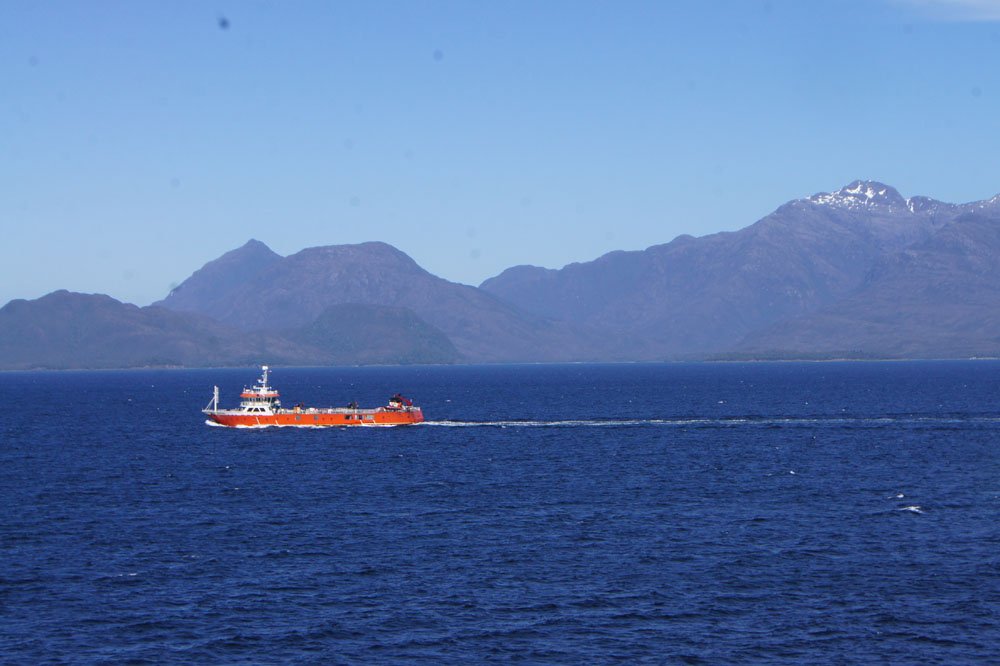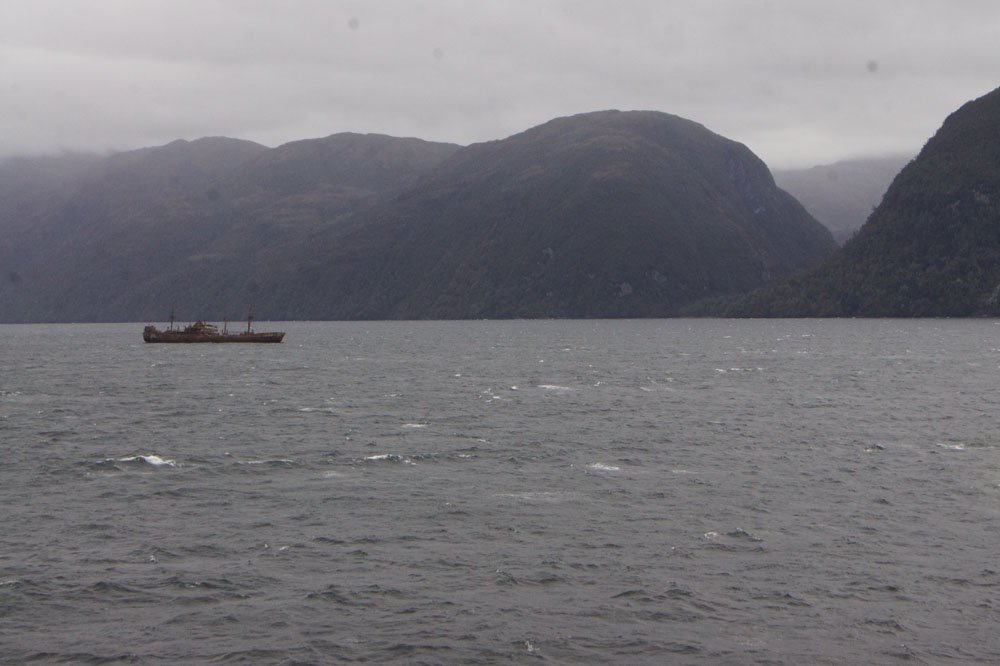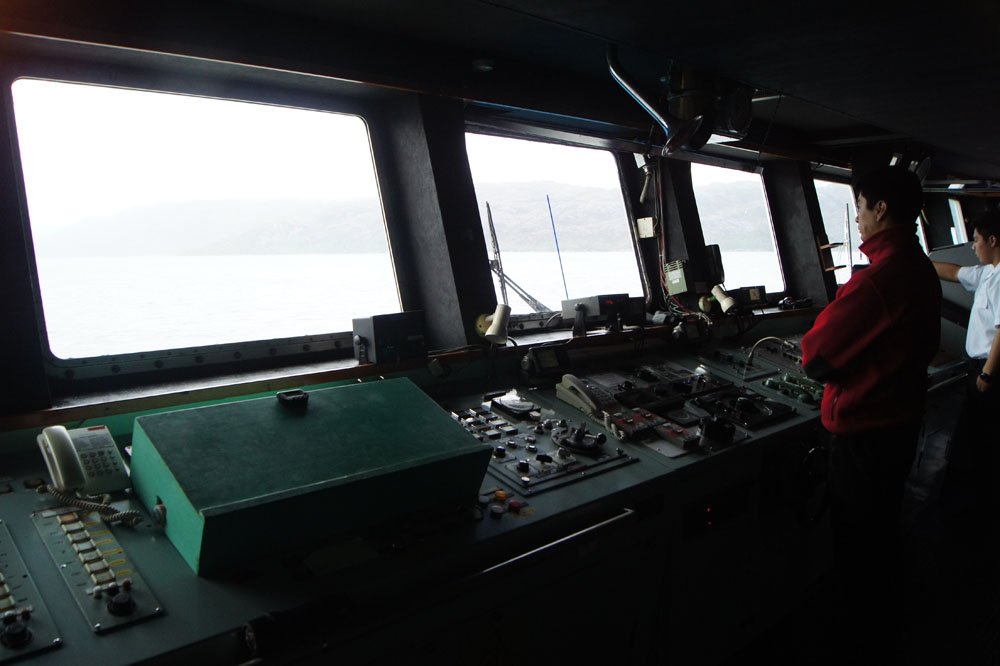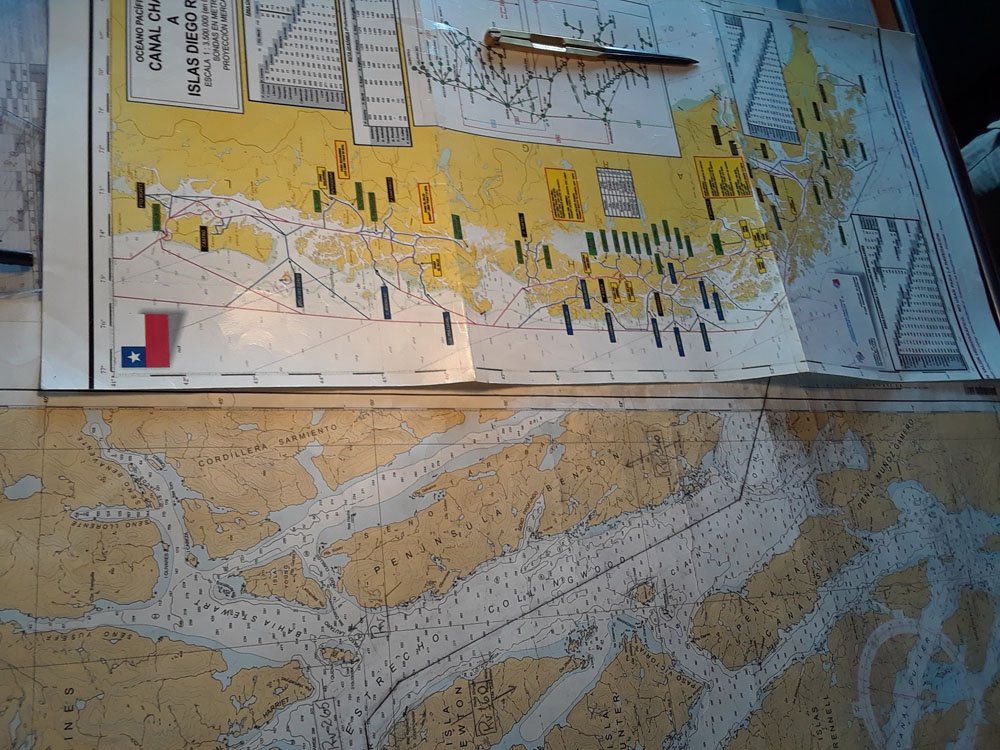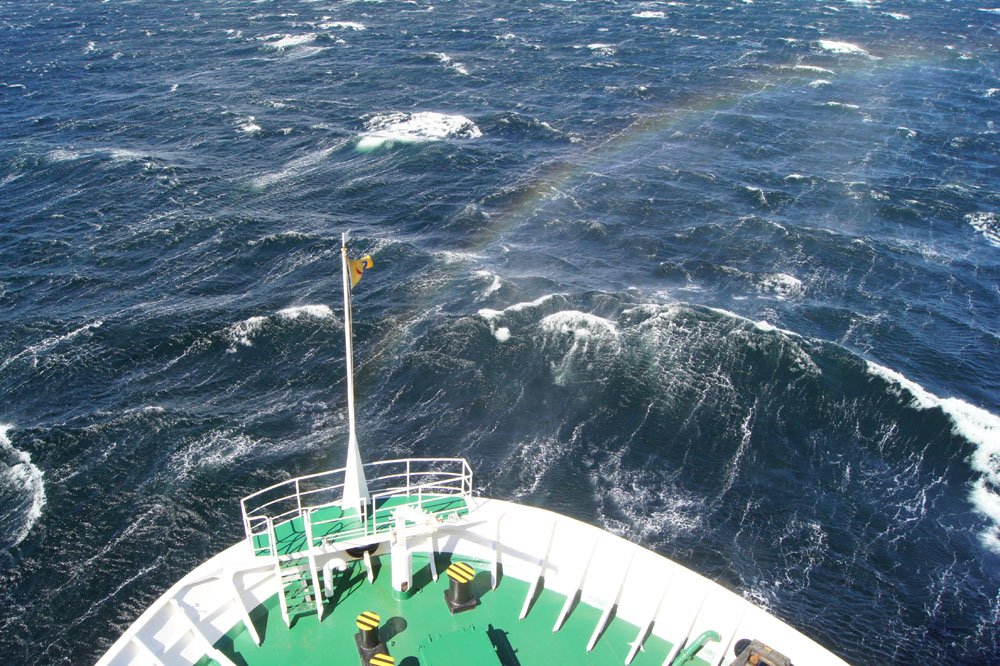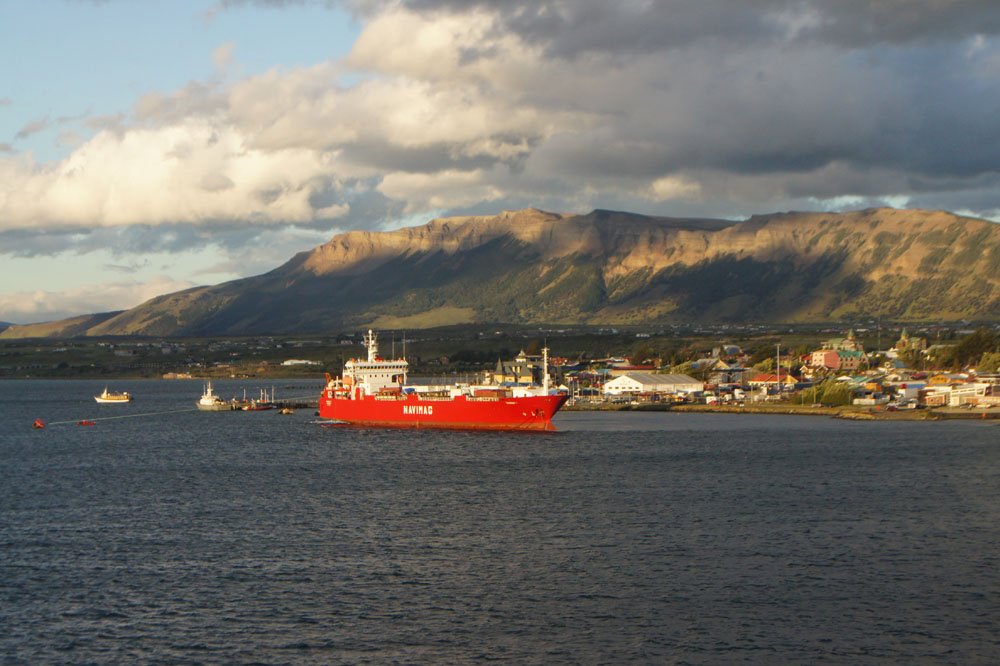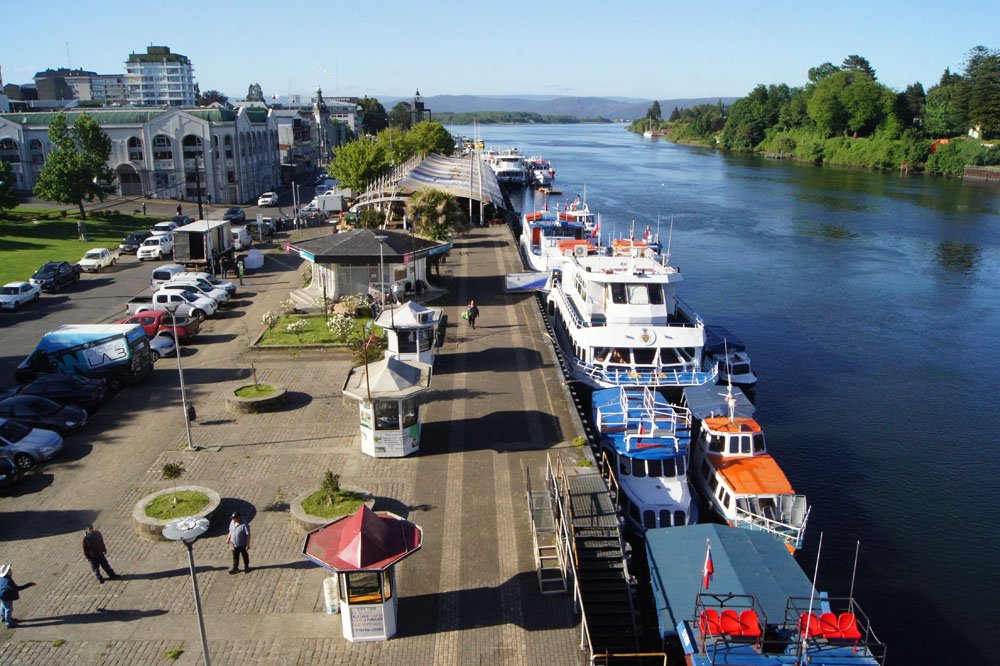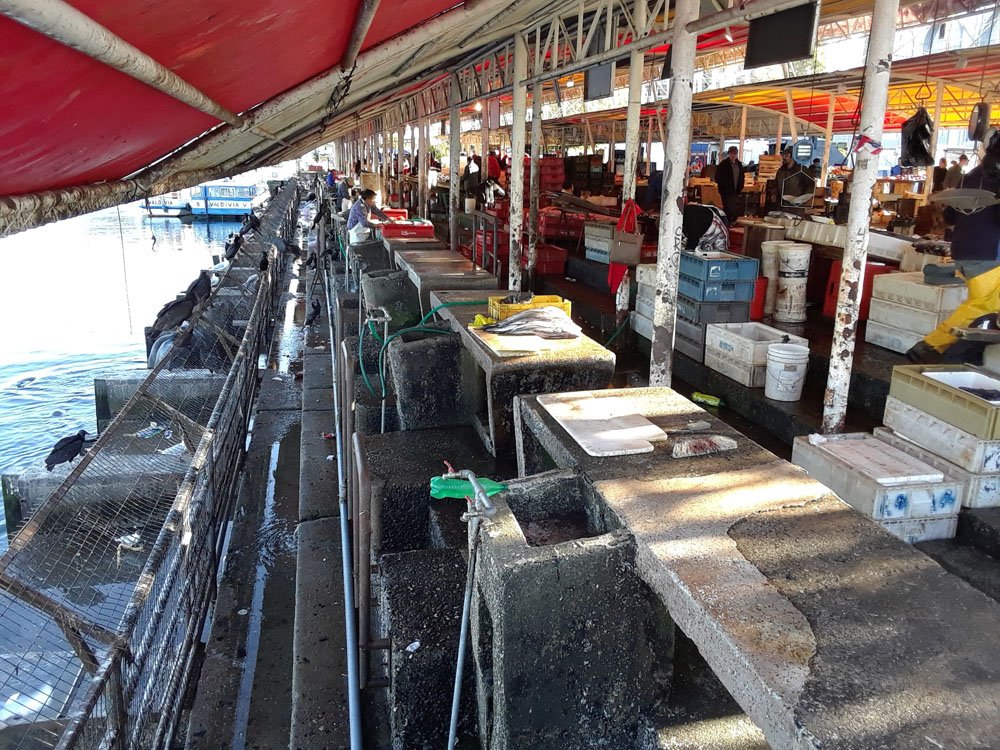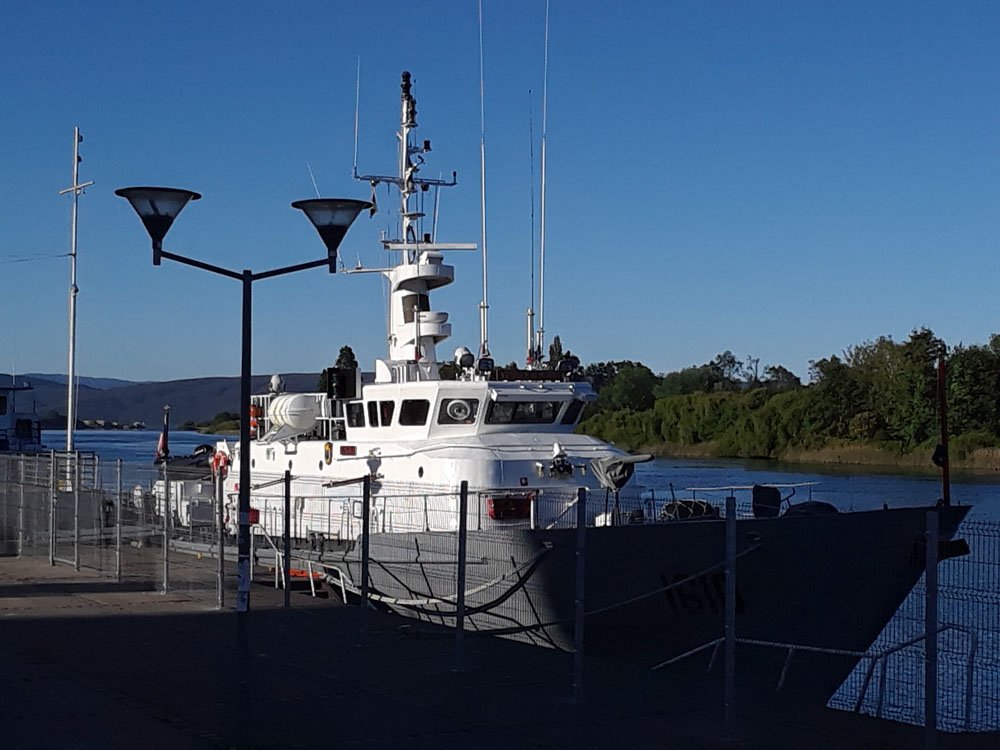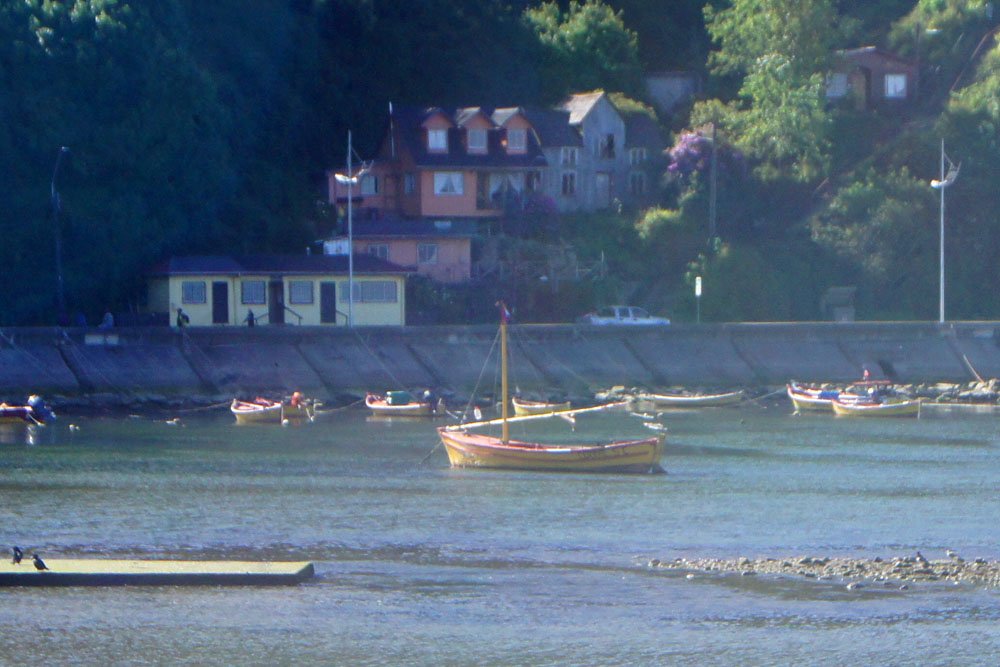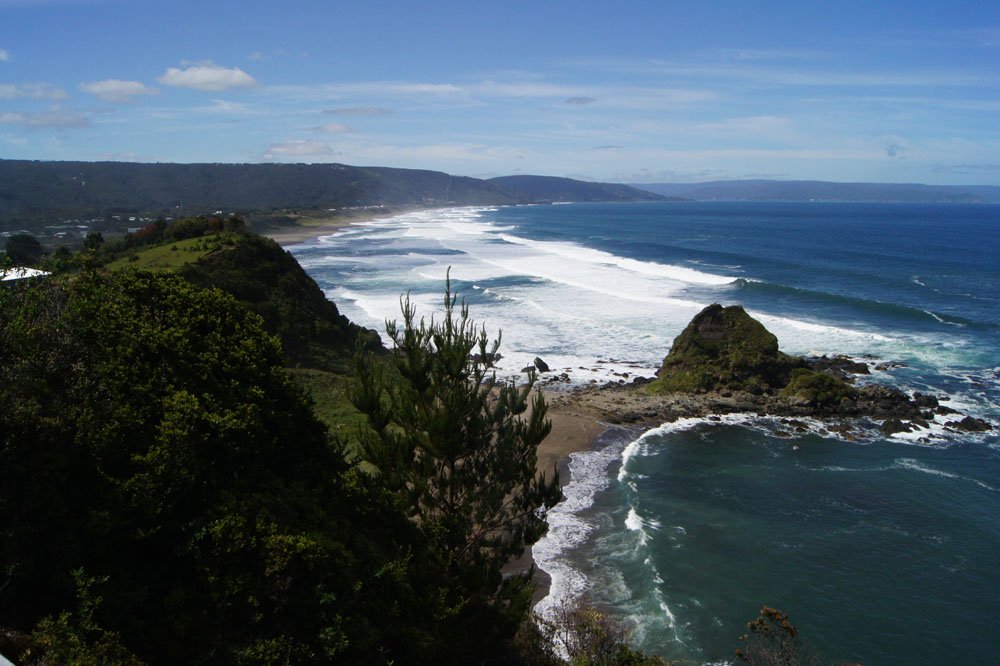-
Posts
3,529 -
Joined
-
Last visited
Content Type
Profiles
Forums
Gallery
Events
Everything posted by Cathead
-
Ironically, given the likes and kind comments, I've decided to redo part of this work. After exchanging messages with Kurt regarding the breechings (the proper term for what I had been calling chimney extensions), I've concluded that they're too large. Kurt pointed out that, from an engineering point of view, exhaust should always be able to travel upward through similar or expanding diameters, not contracting ones. I made the lower breechings about 5' wide thinking that I'd nestle the ~4' chimneys into them, but that violates Kurt's rule. Also, upon reviewing several references, I do notice that the breechings are always drawn as being the same diameter as the chimneys, not significantly wider as on my first version. That hadn't registered on me as being important when I'd looked at them before, but now it does. The good news is that redoing these won't be very hard; the old ones will pop right off the boilers without harming the rest of the detail. There's another question that redoing these will let me address. If you look at my first boiler photo, you'll see safety valves on the left and right boilers but not on the middle one. These were meant to let off excess steam and could either vent into their own little stacks or directly into the main chimneys. I'd meant to have mine vent into the main chimneys, hence their orientation. Here's the odd thing; in all my images of the original boilers, there's no sign of a valve on the central boiler, though you'd think there would be (I can clearly see the left and right values and smooth metal on the central boiler where a valve should be). Moreover, if there had been a central valve, how would the engineers have reached it when the boiler tops are well over their heads and the breechings would have blocked access from the front? I need to decide whether to add a central valve, because having it vent into the breeching requires a slight redesign of the latter. Any experts have an opinion on why there would or wouldn't have been a central valve? It's going to be -8 °F (-22 °C) here tonight, but a lot colder even a little to the north; Chicago is forecast for two nights of -21 (-30) and Minneapolis -28 (-33). Hope everyone to my north does ok in this frigid blast. We brought our chickens into the garage for a few days, as much for our own comfort as for theirs!
- 599 replies
-
- sidewheeler
- arabia
-
(and 4 more)
Tagged with:
-

Exploring the maritime history and geography of Chile
Cathead replied to Cathead's topic in Nautical/Naval History
HMS Beagle replica: Views fore and aft. That's me on the forecastle with the Magellan Straight behind me. View near the wheel. Inside the chartroom, and posted around the ship, are myriad sheets of plans and drawings that are great to study while standing on the full-size equivalent. View belowdecks, looking aft toward the officers' quarters. Me and my namesake. Another view from the bow. It was just mind-blowing to walk around, and on, this vessel. I'm not enough of an expert to know if any details are wrong, but they sure seemed to try for authenticity. It was close enough for me. Both Mrs. Cathead and I reread Voyage of the Beagle in preparation for this trip (we both have a background in earth science and strong interests in ecology & natural history), so we both got a lot out of this visit. It amazes me that there aren't truly accurate kits of the Beagle, and I have to admit that scratchbuilding this is high on my potential next-project list. Really, how could the household of two travel-loving natural history lovers not have this? -

Exploring the maritime history and geography of Chile
Cathead replied to Cathead's topic in Nautical/Naval History
De nada, mi amigo, estoy agradecido que lo disfrute. Nos encanta Chile, un pais maravillosa. Espero que puede entender mi español, estudio y practico mucho pero necesito aprender mucho mas! Jorge's kind note reminds me that I never finished this series. On to the final, and possibly best, single place in maritime Chile: the Nao Victoria museum in Punta Arenas, Patagonia. Located on the shoreline of the Magellan Straight with a clear view across to Tierra del Fuego, this is a private venture from a history enthusiast who has taken it upon himself to build accurate, full-scale replicas of famous ships in Chilean/Patagonian history. It's an absolutely fascinating location, as you wander around, on, and through Darwin's HMS Beagle, Magellan's Victoria, Shackleton's James Caird lifeboat, and the schooner Ancud that carried the first Chilean colonists to the region. I have tons of photos from here but will just post a few for brevity; anyone looking for more images for research interest can contact me. Look for these coming soon in several posts, as even culling them it's more than one post can handle. -
When I started thinking about laying out the boiler deck, I very quickly realized that I had further work to do on the main deck. For example, the main staircase and the boiler chimneys would both affect the boiler deck's design, so I decided to make those items next. While doing so, I also added more detail to the boilers as this seemed as good a time as any. At this point in the build, I'm moving beyond what's known about the vessel and entering the speculative realm. Steamboats used a variety of main staircase layouts, but I went with the style shown in the "official" painting used by the museum (itself highly speculative, and in my opinion wrong in some cases). You can review this painting in the first post of this build log. I also just like the split staircase design it shows. Because this staircase would be walled in on all sides, I didn't bother carving stringers, but built up the staircase by making individual sets of steps. Each consisted of a vertical and horizontal piece, with a thinner lip under the horizontal piece that served as a platform for the next step. This modular approach was much easier than getting angled stringers right. Once I had the two main staircases done, I attached them to a landing and used a loose piece of wood as a spacer across the time to keep things stable for the moment. Next, I walled in the sides and back, using pre-scribed wooden sheets left over from building model railroad structures. These made things a lot faster and look good enough for this internal, partly hidden feature. I also extended the landing down to deck level. Notice the slot I left below the landing; this let me slip the assembly of the last three steps (see previous photo) in there for a more secure fit. I also started painting the interior while I had better access. A view of the walled-in back. I carved slots in the edges of the scribed sheets to mimic board edges. The mostly completed staircase; it'll show up again in a few photos in its final form. Meanwhile I also started laying out out the chimney extensions, the oddly shaped bits that connects the three boilers to the two chimneys. These seem to have varied quite a bit in design from boat to boat and I have no idea what Arabia's looked like. So I studied the drawings and info for Bertrand and Chaperon as well as what else I could find, and just invented a design that worked for me. This was built from wood sheets. I considered overlaying this with thin styrene so I could get some rivet details in there, but decided not to for three reasons. First, getting nice corner seams with all these unusual angles would be really hard. Second, I had no idea how the metals sheets for this might have been laid out. Third, most of this won't be very visible as it's up under the boiler deck and mostly in shadow. So I decided that a relative lack of detail would help it blend into the shadows, while incorrect detail might draw attention to it. On Model Shipways' Chaperon model, this also seems to be simulated by a fairly basic piece. And here are a few views of the finished staircase and the updated boilers. I added the steam drum (atop the boilers) and mud drum (below the boiler), pressure valves (atop, near the chimneys), and more. I also drybrushed some brown pastel to simulate subtle rust and vary the texture. It doesn't show up strongly, but that's kind of what I want. I don't want this looking like a rust-bucket, just a well-used but well-maintained vessel. If desired, you can review photos of the original boilers here. On the finished vessel, this will all be obscured under the overlying deck and behind a variety of other support beams and cargo. On the steam drum, note the two tubes sticking out aft (left) with short wires coming out of them. This is where the steam lines will run back to the engines once this is all permanently installed. I drilled and inserted those wire stubs there so it would be easier to attach and align the steam lines later on, because I'll likely be installing them after the next deck is in place since they're supported from the overlying beams. View from above. I also used a brush to spread some brown pastel down the centers of the staircases, to simulate the inevitable dirt tracked along by many boot and shoes. The interiors of the chimney extensions aren't painted because they'll be filled when the chimneys go in later on. View from above and astern, somewhat similar to this original view of the wreck. Overview. I took these on my kitchen table for better natural light, as it's too cold out to use my normal porch location. Note the jugs of homemade mead and strawberry wine fermenting in the background. The top of the staircase represents the next deck level; the chimney extensions jut a little higher up because they're meant to go through the deck. I've set the boiler deck to be 13' above the main deck. For reference, Bertrand's decks were separated by 12' and from what I can tell online, Chaperon was similar. So that's the progress of the last few weeks. I also need to build the two separate pumps (the doctor and the manual) that sit behind and next to the boilers, respectively, and figure out what other main deck details I want to develop before starting on the next deck. Thanks for reading!
- 599 replies
-
- sidewheeler
- arabia
-
(and 4 more)
Tagged with:
-
Anna, You're right that glue won't bond well to wet wood. The best approach is to soak the wood and clamp it in place until it dries, after which it will hold its form well enough to be glued. If you don't have clamps that fit a certain piece, you can try using small nails that you then withdraw once it's done. You're moving right along!
-
You're doing great, especially for a first build. Looks better than mine, which wasn't a first build!
- 50 replies
-
- model shipways
- 18th century longboat
-
(and 1 more)
Tagged with:
-
For what it's worth, I'm not sure about Chaperon's later era, but in my understanding the hog "chains" on earlier boats were generally solid metal rods, not cables or chains, meaning they can be simulated with straight brass rod. I assume Kurt knows the proper details for Chaperon. Model's looking great. I see what you mean on the wheel timbers, I didn't notice in the oblique views of your first post but it's more clear in the side views. The good news, at least, is that no one who isn't a serious expert will likely notice, although I know what you mean about the frustration of finding something you know about and can't really fix.
- 76 replies
-
- model shipways
- chaperon
-
(and 1 more)
Tagged with:
-
Bob, Yeah, central Missouri really was the focus of this storm. Check out this snowfall map from last night, posted by the St. Louis National Weather Service office. We're near the center of that bullseye, and the totals have gone up since then. It's still snowing as I type, though only flurries at this point. I loved snow growing up and still do, but being a home/landowner does change one's perspective on the ratio of fun/work it can cause.
- 599 replies
-
- sidewheeler
- arabia
-
(and 4 more)
Tagged with:
-
Plaster is a great idea, as I agree the wood grain was obnoxious. However, I don't have any and can't think of any other use, so am reluctant to buy it just for this tiny application. I'm guessing I can't buy just the half ounce I need? Or are there other relevant uses that would justify buying a larger quantity? And what kind would you suggest?
- 599 replies
-
- sidewheeler
- arabia
-
(and 4 more)
Tagged with:
-
So, you know how I said we had a "snowy weekend" coming up? Well, that turned into the third-highest snowfall on record for this part of Missouri at 16.4" as of this morning and it hasn't stopped (that's over 40 cm for you folks in sensible countries). Where I grew up, along the Great Lakes, this wouldn't be all that special, but out here in the southern Midwest it's pretty spectacular. I'd enjoy it more if it didn't create so much work, between trying to plow out our long, steep driveway (we live in a narrow rural creek valley) and working to keep our hundreds of young pine trees and fruit trees from breaking under the strain. Here are a couple photos, which don't do the snow justice as it's already begun to settle and compact. It was nearly to my knee and I'm 6' tall (and we had no wind, that's all straight accumulation, not drifting). We moved here in 2006 and have now been present for three of the top five snowfalls on record (going back to at least the late 1800s). One of my full-scale wood projects, a garden shed built entirely from cedar we cut and milled on-property. Kitchen porch buried. The bird feeders need air traffic control, but unfortunately they're furloughed due the the US government shutdown. Anyway, due to the scope of this storm I didn't do as much model work as I hoped, but made some progress. The basic boiler structure is essentially done, though I may add a few details. I also made the brick paving that goes in front of the furnaces, so ashes could be scooped out without setting the deck on fire. Here's a portion of the original from the museum: And here's my version, made by carving a piece of wood with a razor saw and file, then using multiple layers of stain and pastel to subtly vary the bricks. It wouldn't stand up to really close scrutiny (like a camera lens) but it'll only be viewed obliquely on the model, so I'm not too worried. And here's a few shows of the boilers placed on the model temporarily. I also drilled holes in the engine assemblies and decks so I could set them in place using pins. This is nice because (a) they always go to the right (same) place now and (b) are more stable when on the deck. I'm not going to glue them on until the last minute because it'll be very useful to lay out the next deck on the open main deck. I think that, next up, I'll start laying out the boiler deck (the deck above this one, so named despite not having the boilers on it).
- 599 replies
-
- sidewheeler
- arabia
-
(and 4 more)
Tagged with:
-
Anna, There are various ways to bend a plank like that. I like to soak the plank in warm or hot water, which makes it more flexible. Then, when it's damp, you can clamp it into a curve and let it dry. Once dry, it will hold the shape you want. Some people advocate using a hot-air dryer (like for hair) either in place of water or after soaking. Either way, the heat helps loosen the wood fibers and make them easier to bend. Several warnings: First, different types of wood bend more easily or with more difficulty, so you have to be careful and bend slowly to find out whether your piece risks breaking. Second, you can clamp a wet piece of wood directly on the model if the wood underneath won't show (like structural bulkheads), but in your case as you've already placed other finished wood there, doing so risks warping the wood below. So I suggest finding a curve surface with a similar radius, like a pot or bucket, and clamping the plank you want to bend to that. Third, clamping too hard to compress the wet wood fiber and ruin the piece. Again, be careful as you do this. Sometimes it's best to use another, thicker piece of wood between your plank and the clamp to avoid direct imprints into the plank. I suggest trying this once or twice with scrap pieces if you have any, to get the hang of it before you try on a good piece. Good luck! On your next model, this is also how you would approach bending planks for the hull so that they have a smooth curve.
-

Shopping on eBay: A Primer for Newbie Ship Modelers (Parts 1 and 2)
Cathead replied to ccoyle's topic in Wood ship model kits
Great topic. Another point I feel is important is Don't Be Cheap. Frugal, sure. Cheap, no. It costs money for small businesses to design, manufacture, and sell models. If you can't afford a model, you can't afford it; look for something else that's in your price range or learn to scratchbuild what you want. Sure, I'd like to have a nicer vehicle, but I'm not going to buy a stolen one to achieve that, or use a sketchy dealer that will likely cheat both me and the government. If I want to spend more money, I have to save or budget for that or accept that life doesn't revolve around getting what I want right now. This means don't get sucked into aggressively looking for crazy deals, because for the most part they don't exist. If you want a model, save up for it (or crowdfund it through gifts from family) and pay the reputable manufacturer (or dealer) what it's worth while feeling good that you supported a legitimate part of the small-business economy. Live (and model) within your means and pay others the respect of supporting their efforts to do the same. -
Great ideas, folks. I particularly like the advice to use a doorknob to save the palm. I had red spots on my hand for days from the pressure of the screwdriver handle. The stop collar is also quite sensible. In the back of my mind I kind of knew that others must have solved this before, but I got pleasure out of figuring out a way myself. Sometimes reinventing the wheel is fun when you're looking for a mental challenge, as I was when doing this. After a day working at a computer, research often isn't high on my recreational list but tinkering is! Unfortunately I haven't done much more than paint the assembly already shown. It's been one of those weeks where other stuff keeps getting in the way. Plus, last weekend was gorgeous so we went hiking. With a snowy weekend coming up, I expect to get back to work.
- 599 replies
-
- sidewheeler
- arabia
-
(and 4 more)
Tagged with:
-
Kurt, if you don't mind, I'll grab that too for when I reach that stage on the Arabia. Bob's exactly right.
- 76 replies
-
- model shipways
- chaperon
-
(and 1 more)
Tagged with:
-
Welcome to MSW from another Missourian. I'd suggest that you do start a build log, as that's the primary way you'll be able to get help and advice from others. It's not really about "showing off", more about providing a clear documentation of what you've done so others can better follow along and help you. I also find that maintaining a log, while sometimes time-consuming, is also a really good motivational factor for keeping at the project. Having to think about and write up what I'm doing also serves as a self-fulfilling form of problem-solving. In any case, good luck with your Rattlesnake!
-
It already is. I still have to be careful what I pick up and how, and I've had to skip a number of really nice weather days that would have been great for cutting next year's firewood. Being relatively young and pretty healthy certainly helps, but it's annoying nonetheless. I'm really looking forward to finishing the machinery, it's my least favorite part of a steamboat build. Can't wait to get started on the next deck.
- 599 replies
-
- sidewheeler
- arabia
-
(and 4 more)
Tagged with:
-
Work has finally commenced on the poor, neglected Arabia. My shoulder is slowly improving with rest; it's still sore but I've been able to cook and do dishes again. Driving my stick-shift truck is probably the most problematic behavior I can't avoid, but since I work at home I only have to do that once a week or so. Most importantly, I can cut, sand, glue, and paint! I decided to tackle the boilers next. See my design thread for a full review of the original components, but below are reposted the two best photos I know of showing the boilers still at the wreck site. The first decision I need to make was how to simulate the rivets joining the roughly 2' wide sheets of iron composing the boiler tubes and the skirting around them. I had already purchased a dowel of the right diameter for the boiler tubes (about 3.5' wide and 24' long). So I dug around in my scrap box and turned up a very thin sheet of scribed styrene originally meant to simulate siding for model railroad buildings. Experimentation showed that the scribing was perfect for allowing the sheets to bend around dowel, so I marked off three pieces necessary to wrap half of each dowel. I did only half because (a) the bottom half won't be seen and (b) this one piece of perfect scrap wasn't big enough to do the rest. Next I experimented with punching divots into the styrene to simulate rivets. I tried a variety of tools, from pointed files to pencils, and finally settled on a small Phillips screwdriver that made nice indentations while being too blunt to go through the material. It was also more ergonomic to use than other options, important since I'd be doing a lot of this. Once I was happy with my method, I carefully measured out 2' increments along the boilers and began punching manually. I think the results look quite good, as seen below. To attach these sheets to the boiler dowels, I laid a line of CA down the middle of each sheet and glued it to the dowel. Once that set, I laid another line of CA along one edge, wrapped and clamped that, then did the other side (see above). This worked nicely, though I had to work quickly to get the clamps set before the CA set. Next I started building a cradle to hold the boiler tubes and support the rest of the boiler structure, as seen below with the finished boilers. Here are the boiler tubes resting in their cradle; you can start to envision the final product. Next, I painted the tubes with the same black I used for the engines. It's a thick Model Shipways paint that does a decent job of blending different materials together and giving a metal-like finish. I'll dull the finish with some pastels. Next, I started expanding the rest of the structure, adding details made of wood and thin styrene to simulate the various furnace doors, ash doors, legs, and other parts of the boiler assembly. I also added sheeting along both sides, using the same rivet-punch technique as the boilers. That's where the boilers stand now. Next, I'll finish adding details and structural elements, finish painting, and weather it with pastels. Then I'll have to decide how much of the detailed piping I want to install, I don't think I can handle all of it, so I'll work out a reasonable simulation. If you go back to the design thread linked above, you'll see what I mean at the stern end of the boilers. Still, I think this looks pretty good for something knocked together from mostly scrap parts, with a sore shoulder. On the finished model, it'll be somewhat buried in the shadows of the main deck, so I don't feel the need to simulate every detail. I'm a big believer in creating the illusion of accuracy rather than counting every rivet. Thanks for sticking with me over the long delay.
- 599 replies
-
- sidewheeler
- arabia
-
(and 4 more)
Tagged with:
-

Exploring the maritime history and geography of Chile
Cathead replied to Cathead's topic in Nautical/Naval History
Continuing south, it's time for one of Chile's greatest maritime experiences, the ferry route to Patagonia. South of Puerto Montt, the mainland breaks up into over 1,000 km of islands, fjords, and mountains capped by two major ice sheets. It's not possible to travel to Chilean Patagonia by land unless you cross the Andes into Argentina, but there is a ferry service that runs through the fjordlands to Puerto Natales. Similar to the Alaskan Ferry system (which I've also used), this is a working service whose primary purpose is to serve communities and locals in the region, but which carries tourists as well to balance the books. The voyage takes four days and three nights, all of which are overloaded with scenery, bird-watching, and of course interesting maritime traffic. The Evangelistas was build in 1978 (about my age) and measures about 115x21 m with a draft under 5 m. She takes many hours to load with trucks, trailers, and other cargo, which seasonally can include livestock from Patagonian ranches. Above, you see the stern-loading ramp extending to shore at Puerto Montt. She also carries around 300 passengers (both tourists and regional residents) and 40 crew. A different, but similar Navimag ferry encountered on the voyage gives a rough sense of context. I never got a shot of the Evangelistas, though she's easy to Google if you want to, because we didn't have a chance while boarding and we didn't disembark until after dark (and she sailed the next morning before we got back down to the harbor). Puerto Montt, like Valparaiso, is chock full of interesting shipping. In many ways, visiting Chilean ports felt like time traveling back 70 or 100 years, because there's so much greater diversity in the size and nature of the shipping, and much more cargo handling is done by hand or small crane. Everything from small-medium ocean-going freighters to little flat-bottomed lighters shuttling things all over the harbor; it was a bustle of activity that felt very different from modern US ports with their super-large shipping. I could have spent all day watching this. The Orca Yagan, which is listed online as a Fish Carrier. I assume this means it services the myriad salmon farms spread throughout Chilean Patagonia. I'm not a big fan of fish farming, but this was a very attractive vessel, especially clean and well-kept. This neat little tug was hovering around the ferry, bobbing like a cork in the tiniest waves. We saw a lot of ships of this general type; I have no idea what they are, but most had lots of piping and equipment on their rear decks, suggesting they aren't cargo ships. There's oil and gas exploration in southern Patagonia, but not in the fjordland area, so I don't know what these are. The wreck of a Greek freighter, I believe from the 1950s, deep in a remote Patagonian fjord. It's sitting on solid ground, a sunken hilltop that forms a dangerous reef in the middle of the fjord. We particularly enjoyed being allowed to visit the bridge. They have a modern navigation system shoehorned in at far right, but are clearly comfortable with older methods of navigation. There's a big chart table that has a full set of charts always at the ready, which we enjoyed poring over. Some of these fjords are over 600 m deep, often deeper than they are wide. Patagonian wind earns its reputation. Here, it was screaming from astern and whipping sheets of spray off the water into walls of mist that carried forward like curtains. With the sun at the correct angle, beautiful rainbows arced from the bow. Very few people saw this, as most were huddled indoors. We spent 95% of our time on deck regardless of weather and were rewarded with wonderful experiences like this, as well as all sorts of good birds and other marine life (like the relatively rare Chilean dolphin along with albatrosses and skuas). Arriving in Puerto Natales in southern Chilean Patagonia, we had to wait for this Navimag freighter to clear the one loading dock. Everything was delayed because the wind was too strong to allow safe departure or arrival; we circled the harbor for hours waiting for it to die down with evening. We didn't disembark until after 11pm, dark even in high-latitude summer, but the sunset over the town and harbor gave glorious light. Just astern of the freighter is another patrol boat very similar to the one shown above in Valdivia. In the next installment, we'll head further south to Punta Arenas on the Straights of Magellen, and an amazing museum with full-size replicas of historic ships. -
Ooh, she's pretty. Love the multi-wood effect.
- 171 replies
-
- artesania latina
- bounty
-
(and 1 more)
Tagged with:
-
Like Bob, I just found your log with your latest update. Your work looks great, I'm sorry I've missed following along so far. It's nice to see another good Chaperon build.
- 76 replies
-
- model shipways
- chaperon
-
(and 1 more)
Tagged with:
-

Exploring the maritime history and geography of Chile
Cathead replied to Cathead's topic in Nautical/Naval History
Valdivia has other nautical attractions in addition to the forts. The town's waterfront hosts a variety of tour boats that visit the forts by sea as well as exploring a large nature reserve upriver. The large structure at center is the town's market, where a wonderful mix of fresh produce, cheese, and seafood are sold. The seafood stalls back up to the water, making disposal of offal and other fresh refuse easy. Chile's fresh seafood is one of the country's greatest assets to a visitor. Lest this seem wasteful or polluting, a large population of gulls and sea lions happily takes care of anything going over the side: Among the interesting vessels tied up along the waterfront, we found an old Chilean Navy submarine (open for tours, but not when we were there) and this modern patrol vessel: The region also hosted many interesting fishing boats. Most noticeable were a distinct style of open boat, always painted red and yellow, an example of which I saw in the Valparaiso Museuo Naval. These, however, were often rigged with simple triangular sails. Looking out to sea from the Niebla Fort, I could see a series of these far out with their sails rigged, but my camera wasn't good enough to capture them. Here are two not-so-great photos of the type in harbor: I wanted to learn more about these, but couldn't get clear answers from local fishermen. When I asked what they were called, for example, all I could get was "lancha", which is a generic Spanish word for "launch" or "boat". Online searches have turned up nothing more (not even better photos), and my Spanish isn't good enough to dig deep into historical archives. If/when I return, I'd like to focus on learning more about these; they were the first time I've ever seen sail-based fishing boats in actual operation. They'd make a really interesting modeling project if I could get enough information and better photos. Much of this part of the coast reminded me of northern California or southern Oregon, with rocky headlands separating beaches and isolated fishing villages. A particularly nice location is Curiñanco, to the north, where a nature reserve protects huge old trees on steep slopes above the water and a rocky beach generates beautiful waves and preserves some really interesting bedrock geology (what looked to us like deposits from past tsunamis along this very tectonically active coast). -
What you're doing IS therapy. Most of us benefit from the ability to obsess over something harmless, such as hobbies or sports, or reality can overwhelm us. Having recently visited Valparaiso, where Essex was captured, my interest in following a build of her has been heightened and I'll look forward to learning from this one.
About us
Modelshipworld - Advancing Ship Modeling through Research
SSL Secured
Your security is important for us so this Website is SSL-Secured
NRG Mailing Address
Nautical Research Guild
237 South Lincoln Street
Westmont IL, 60559-1917
Model Ship World ® and the MSW logo are Registered Trademarks, and belong to the Nautical Research Guild (United States Patent and Trademark Office: No. 6,929,264 & No. 6,929,274, registered Dec. 20, 2022)
Helpful Links
About the NRG
If you enjoy building ship models that are historically accurate as well as beautiful, then The Nautical Research Guild (NRG) is just right for you.
The Guild is a non-profit educational organization whose mission is to “Advance Ship Modeling Through Research”. We provide support to our members in their efforts to raise the quality of their model ships.
The Nautical Research Guild has published our world-renowned quarterly magazine, The Nautical Research Journal, since 1955. The pages of the Journal are full of articles by accomplished ship modelers who show you how they create those exquisite details on their models, and by maritime historians who show you the correct details to build. The Journal is available in both print and digital editions. Go to the NRG web site (www.thenrg.org) to download a complimentary digital copy of the Journal. The NRG also publishes plan sets, books and compilations of back issues of the Journal and the former Ships in Scale and Model Ship Builder magazines.



